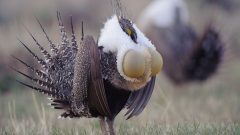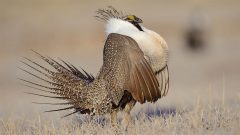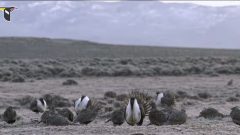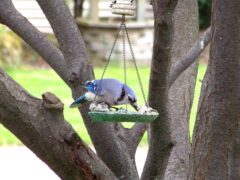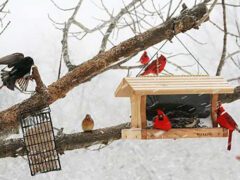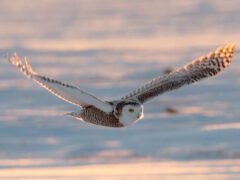Greater Sage-Grouse Similar Species Comparison
Main SpeciesGreater Sage-Grouse
Male
Large chubby grouse with a small head and long tail. Speckled brown and gray above. Males have a white breast, a black belly, and a black throat.
© Ryan Jones / Macaulay LibraryColorado, April 17, 2019Female
Large chubby grouse with a small head. Females are speckled brown and gray above with brown speckling on the throat and a black belly.
© Darren Clark / Macaulay LibraryIdaho, March 29, 2015Male display
One of the characteristic birds of sagebrush country of western North America. Males gather on display grounds, known as leks, to vie for the attention of females in the area.
© Andrew Spencer / Macaulay LibraryColorado, May 09, 2021Male and female
Males spread their tail into a starburst and inflate yellow air sacs in the chest when displaying, giving them a bizarre appearance. Females are much more subdued in appearance; they gather to closely inspect displaying males before mating.
© Darren Clark / Macaulay LibraryIdaho, April 11, 2019Male display
Large grouse that fans its tail into a starburst when displaying and inflates 2 yellow air sacs in the chest.
© Andrew Spencer / Macaulay LibraryColorado, April 18, 2016Male display
Displaying males lunge forward to push air in and out of the yellow air sacs in their chest, making a quiet gurgling or popping sound. They vigorously defend the small display territories on their leks. They often display even when there are no females around.
© Timothy Barksdale / Macaulay LibraryCalifornia, April 13, 1997Male display
Large chubby grouse with a small head and long tail that is fanned into a starburst when displaying. Males also inflate 2 yellow air sacs like round balloons while displaying.
© Matthew Pendleton / Macaulay LibraryUtah, March 25, 2016Male
Displays begin in late winter or early spring, often when there is still snow on the ground.
© Andrew Spencer / Macaulay LibraryColorado, April 18, 2016Female
Large chubby grouse with a small head and fairly long tail. Note the large black belly patch.
© Marcel Such / Macaulay LibraryWyoming, January 04, 2019Similar SpeciesGunnison Sage-Grouse
Male
Male Gunnison Sage-Grouse have longer black plumes on the back of the head and are smaller than Greater Sage-Grouse. Their ranges do not overlap.
© Tim Avery / Macaulay LibraryUtahSimilar SpeciesGunnison Sage-Grouse
Female
Female Gunnison Sage-Grouse are smaller than Greater Sage-Grouse. The two species' ranges do not overlap.
© Will Britton / Macaulay LibraryColoradoSimilar SpeciesSharp-tailed Grouse
Female
Sharp-tailed Grouse are smaller than Greater Sage-Grouse, have a slight peaked crest, and are light brown overall instead of gray. They occur mainly in prairies and open woodland, while sage-grouse live in sagebrush.
© Chris Wood / Macaulay LibraryNorth Dakota, June 15, 2013Similar SpeciesDusky Grouse
Female
Dusky Grouse tend to live in forests rather than sagebrush. They are smaller than Greater Sage-Grouse, with a shorter, square-tipped tail and without a black belly patch.
© Angus Wilson / Macaulay LibraryColorado, May 22, 2016Similar SpeciesDusky Grouse
Male
Displaying male Dusky Grouse have pink to purple patches on the sides of the neck and an even edge to the tail, unlike the Greater Sage-Grouse's yellow chest pouches and pointed, starburst-like tail feathers.
© Andrew Spencer / Macaulay LibraryColorado, April 04, 2014Similar SpeciesSooty Grouse
Female
Sooty Grouse tend to live in forests rather than sagebrush. They are smaller than Greater Sage-Grouse, with a shorter, square-tipped tail and without a black belly patch.
© Alex Lamoreaux / Macaulay LibraryWashington, July 31, 2015Similar SpeciesSooty Grouse
Male
Displaying male Sooty Grouse have yellow to purple patches on the sides of the neck and an even edge to the tail, unlike the Greater Sage-Grouse's yellow chest pouches and pointed, starburst-like tail feathers.
© David Lawrence / Macaulay LibraryWashington, July 21, 2012Similar SpeciesRing-necked Pheasant
Female
Female Ring-necked Pheasants are buffy-brown overall instead of the gray of Greater Sage-Grouse. Pheasants also lack the black belly patch of sage-grouse.
© Chuck Gates / Macaulay LibraryOregon, January 22, 2017Compare with Similar Species
Click on an image to compare
Species in This Family
Pheasants, Grouse, and Allies(Order: Galliformes, Family: Phasianidae)
More to Read
Don't miss a thing! Join our email list
The Cornell Lab will send you updates about birds,
birding, and opportunities to help bird conservation.


















